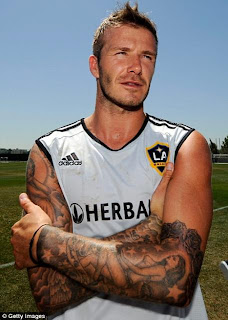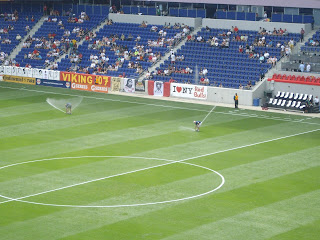Having just moved to Shelburne
Falls, Massachusetts, my partner and I decided to head “into town” one night (town
population: 2,058), where we stumbled upon a small restaurant/bar called the The Blue Rock Restaurant at 10 Bridge Street. The front door, packaged between two other
storefronts, lead us downstairs to a cozy, ‘familiar feeling’ place that was
crowded with locals (and by crowded, I mean that 30 people had us weaving and bobbing to move
from place to place). We sat at the two miraculously open bar stools, and were
immediately engaged in conversation by bartender Jeff Grader.
What followed put the “six-degrees-of-separation”
concept to shame. It’s more like two
degrees. Maybe fewer.
We ordered our pints of Lefty’s Ale,
which the Blue Rock keeps on tap, right in front of the beautiful blue glass
rock provided by a local glassblower whose shop is a stone’s throw away from the
restaurant. Lefty (as I wrote in an earlier post) is a former student of mine who has started his own brewing
company, and now is one of the fastest-growing and most popular craft brewers
in western Massachusetts. It turns out
that our bartender, Jeff, also runs his own graphic design business ("Warped
Whimsy"), and had just completed designing Lefty’s labels for his newest
variety, “Golden Ale.” We launched into
conversation about Lefty and local businesses, about the local artists’ work on
the walls, about the local jazz musicians that play there weekly.
Within a few minutes, we met Chris,
the owner, and a waitress named Holly, who, it turns out, lives across the
street from us.
It was our first time there. It felt like we had been ‘regulars’ for
years. The conversation ran all over the
board, and other patrons joined in as the most incredible aromas wafted from
the kitchen and absolutely artistic meal presentations were delivered to
customers. It was clear this was no
corporate chain, no standardized, bulk-ordered, bland & canned restaurant-supply-house
food.
These were gourmet creations using
local ingredients and personalized recipes.
And everyone there, from the owner to the workers to the diners to those
of us at the bar, knew they were at a special and unique place: a local restaurant drawing on local resources
and serving local customers with local flavor.
We stayed longer than we should
have, but that’s because we entered into a conversation with Holly about her
difficulty finding quality bulk herbs.
Since Danny and I were headed to New York City two days later, we
offered to look for a supplier. Holly
created a list for us, and we said our good-nights.
A few day later, we found ourselves
hunting herbs in New York.
To be sure, bulk spices and herbs are
available in many places, and many large companies package aging spices of
various quality, in bulk, for mass distribution. We wanted something better…and we headed into
Chinatown.
Poking our heads in and out of
stores on the side streets, we found Sun’s Organic Tea Shop at 79 Bayard
Street, between Mott and Mulberry Street.
Sun’s is not a chain, not an outlet,
and not a tourist trap owned by some absentee investor. From the moment we
stepped inside this tiny store packed with jars of herbs and teas and spices,
we knew we were in a one-woman specialty shop. In fact, Sun told us that she
hadn’t had a vacation in years, simply because of her devotion to her store and
her customers.
The walls were lined with glass
jars, each with hand-written labels and prices.
We presented our list and wondered how many she could provide us with:
hibiscus, milk thistle seeds, thistle leaves, lemon verbena, lemon balm. As we rattled off each name, she pointed here
and there, cheerfully telling us that yes, of course she had all of these
herbs, and we began our bulk purchases.
Sun handled measuring out the herbs by the ounce and sealing them in
air-tight bags, as she trusted us pulling and replacing the jars from all over
her shelves. She told us about each herb as she measured, offering special
instructions for the proper use of each, and we felt like we were at a house
party rather than in a store. She threw
in small samples of some herbs we hadn’t ordered for free, and talleyed up the
bill on a hand-held calculator.
We thoroughly enjoyed our shopping
excursion, and left just as some regular customers came in pick up some
specialized teas. A few days later, we were
delivering out treasure to the Blue Rock.
As different as they are – the restaurant
in rural western Massachusetts, and the urban shop in the frenetic streets of
New York’s Chinatown – the Blue Rock and Sun’s share something in common: small, locally-owned and operated businesses,
providing quality products and superior customer service.
Yes, these places still exist…and they will exist as long as we
take the time and effort to patronize them, rather than taking the easy way out
of grabbing shoddy goods at ‘convenient’ one-stop-shopping complexes, at
discount prices. If 9% unemployment and
25% underemployment and a generation of outsourcing have show us anything, it
is that we can not keep running to the cheapest providers of standardized goods
for our consumer needs…it is time to demand healthy local economies, quality
goods, and customer ‘service’ that doesn't come in the form of a scripted call center
message and pressing phone buttons for twenty minutes.
Rather, good neighbors - with their lives and hearts invested in
good businesses, who participate in and contribute to their communities – these
must be the economic future of our society.
[This is the second in a series of posts on Small Business in
America]
.





















































